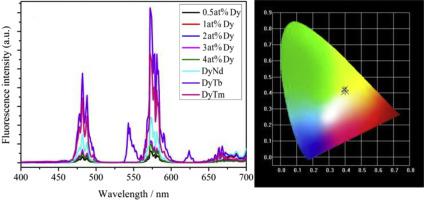当前位置:
X-MOL 学术
›
J. Rare Earths
›
论文详情
Our official English website, www.x-mol.net, welcomes your feedback! (Note: you will need to create a separate account there.)
Structural and optical properties of Dy3+:YAlO3 phosphors for yellow light-emitting diode applications
Journal of Rare Earths ( IF 4.9 ) Pub Date : 2020-07-01 , DOI: 10.1016/j.jre.2020.06.012 Yingshu Lian , Yan Wang , Jianfu Li , Zhaojie Zhu , Zhenyu You , Chaoyang Tu , Yadong Xu , Wanqi Jie
Journal of Rare Earths ( IF 4.9 ) Pub Date : 2020-07-01 , DOI: 10.1016/j.jre.2020.06.012 Yingshu Lian , Yan Wang , Jianfu Li , Zhaojie Zhu , Zhenyu You , Chaoyang Tu , Yadong Xu , Wanqi Jie

|
Abstract The spectroscopic properties of a series of Dy3+ single-doped and Dy3+/Nd3+, Dy3+/Tb3+, and Dy3+/Tm3+ co-doped YAlO3 (yttrium aluminum perovskite, YAP) phosphors were investigated and compared through the measurements of optical absorption, emission spectra, and fluorescence decay curves. For the Dy3+ ion single-doped samples, the intensity of each absorption band increases with an increment in Dy3+ ion doping concentration, and the identified strong absorption peak at 447 nm indicates that Dy3+:YAP phosphors are suitable to be pumped by a blue laser diode (LD). For all co-doped samples, absorption peaks of Dy3+ ion along with some of the absorption bands of Nd3+, Tb3+, and Tm3+ ions are observed. Under 351 and 447 nm excitation, a prominent emission peak at 572 nm was obtained in all the samples, corresponding to Dy3+: 4F9/2 → 6H13/2 transition. Here, 2 at% Dy3+:YAP phosphor exhibits the highest yellow emission intensity under 447 nm pumping. Among the three kinds of Dy3+ co-doped phosphors, Dy3+/Tb3+:YAP phosphor possesses the dominant yellow emission. The fluorescence decay curves show exponential behaviour and are fitted well. The Commission International de L'Eclairage (CIE) chromaticity coordinates were calculated following the respective emission spectra, and it is found that all the coordinates locate in the yellow region. The energy transfer (ET) processes were investigated and the concentration quenching mechanism was discussed. The obtained results suggest that Dy3+-activated YAP phosphors are good candidates for yellow LED applications.
中文翻译:

用于黄色发光二极管应用的 Dy3+:YAlO3 荧光粉的结构和光学特性
摘要 通过光吸收、发射光谱的测量,研究并比较了一系列 Dy3+ 单掺杂和 Dy3+/Nd3+、Dy3+/Tb3+ 和 Dy3+/Tm3+ 共掺杂 YAlO3(钇铝钙钛矿,YAP)荧光粉的光谱特性。 , 和荧光衰减曲线。对于 Dy3+ 离子单掺杂样品,每个吸收带的强度随着 Dy3+ 离子掺杂浓度的增加而增加,在 447 nm 处确定的强吸收峰表明 Dy3+:YAP 荧光粉适合由蓝色激光二极管泵浦(LD)。对于所有共掺杂样品,观察到 Dy3+ 离子的吸收峰以及 Nd3+、Tb3+ 和 Tm3+ 离子的一些吸收带。在 351 和 447 nm 激发下,所有样品均在 572 nm 处获得了显着的发射峰,对应于 Dy3+:4F9/2 → 6H13/2 过渡。此处,2 at% Dy3+:YAP 磷光体在 447 nm 泵浦下表现出最高的黄色发射强度。在三种 Dy3+ 共掺杂荧光粉中,Dy3+/Tb3+:YAP 荧光粉具有占主导地位的黄色发射。荧光衰减曲线显示指数行为并且拟合良好。根据各自的发射光谱计算了国际照明委员会(CIE)色度坐标,发现所有坐标都位于黄色区域。研究了能量转移(ET)过程并讨论了浓度猝灭机制。获得的结果表明 Dy3+ 激活的 YAP 荧光粉是黄色 LED 应用的良好候选者。在三种 Dy3+ 共掺杂荧光粉中,Dy3+/Tb3+:YAP 荧光粉具有占主导地位的黄色发射。荧光衰减曲线显示指数行为并且拟合良好。国际照明委员会(CIE)色度坐标根据各自的发射光谱进行计算,发现所有坐标都位于黄色区域。研究了能量转移(ET)过程并讨论了浓度猝灭机制。获得的结果表明 Dy3+ 激活的 YAP 荧光粉是黄色 LED 应用的良好候选者。在三种 Dy3+ 共掺杂荧光粉中,Dy3+/Tb3+:YAP 荧光粉具有占主导地位的黄色发射。荧光衰减曲线显示指数行为并且拟合良好。国际照明委员会(CIE)色度坐标是根据各自的发射光谱计算的,发现所有坐标都位于黄色区域内。 ? ? ? ? ? ? ? ? ? ? ? ? ? ? ? ? ? ? ? ? ? ? ? ? ? ? ? ? ? ? ? ? ? ? ? ? ? ? ? ? ? ? ? ? ? ? ? ? ? ? ? ? ? ? ? ? ? ? ? ? ? ? ? ? ? ? ? ? ? ? ? ? ? ? ? ? ? ? ? ? ? ? ? ? ? ? ? ? ? ? ? ? ? ? ? ? ? ? ? ? ? ? ? ? ? ? ? ? ? ? ? ? ? ? ? ? ? ? ? ? ? ? ? ? ? ? ? ? ? ? ? ? ? ? ? 研究了能量转移(ET)过程并讨论了浓度猝灭机制。获得的结果表明 Dy3+ 激活的 YAP 荧光粉是黄色 LED 应用的良好候选者。根据各自的发射光谱计算Eclairage(CIE)色度坐标,发现所有坐标都位于黄色区域。研究了能量转移(ET)过程并讨论了浓度猝灭机制。获得的结果表明 Dy3+ 激活的 YAP 荧光粉是黄色 LED 应用的良好候选者。根据各自的发射光谱计算Eclairage(CIE)色度坐标,发现所有坐标都位于黄色区域。研究了能量转移(ET)过程并讨论了浓度猝灭机制。获得的结果表明 Dy3+ 激活的 YAP 荧光粉是黄色 LED 应用的良好候选者。
更新日期:2020-07-01
中文翻译:

用于黄色发光二极管应用的 Dy3+:YAlO3 荧光粉的结构和光学特性
摘要 通过光吸收、发射光谱的测量,研究并比较了一系列 Dy3+ 单掺杂和 Dy3+/Nd3+、Dy3+/Tb3+ 和 Dy3+/Tm3+ 共掺杂 YAlO3(钇铝钙钛矿,YAP)荧光粉的光谱特性。 , 和荧光衰减曲线。对于 Dy3+ 离子单掺杂样品,每个吸收带的强度随着 Dy3+ 离子掺杂浓度的增加而增加,在 447 nm 处确定的强吸收峰表明 Dy3+:YAP 荧光粉适合由蓝色激光二极管泵浦(LD)。对于所有共掺杂样品,观察到 Dy3+ 离子的吸收峰以及 Nd3+、Tb3+ 和 Tm3+ 离子的一些吸收带。在 351 和 447 nm 激发下,所有样品均在 572 nm 处获得了显着的发射峰,对应于 Dy3+:4F9/2 → 6H13/2 过渡。此处,2 at% Dy3+:YAP 磷光体在 447 nm 泵浦下表现出最高的黄色发射强度。在三种 Dy3+ 共掺杂荧光粉中,Dy3+/Tb3+:YAP 荧光粉具有占主导地位的黄色发射。荧光衰减曲线显示指数行为并且拟合良好。根据各自的发射光谱计算了国际照明委员会(CIE)色度坐标,发现所有坐标都位于黄色区域。研究了能量转移(ET)过程并讨论了浓度猝灭机制。获得的结果表明 Dy3+ 激活的 YAP 荧光粉是黄色 LED 应用的良好候选者。在三种 Dy3+ 共掺杂荧光粉中,Dy3+/Tb3+:YAP 荧光粉具有占主导地位的黄色发射。荧光衰减曲线显示指数行为并且拟合良好。国际照明委员会(CIE)色度坐标根据各自的发射光谱进行计算,发现所有坐标都位于黄色区域。研究了能量转移(ET)过程并讨论了浓度猝灭机制。获得的结果表明 Dy3+ 激活的 YAP 荧光粉是黄色 LED 应用的良好候选者。在三种 Dy3+ 共掺杂荧光粉中,Dy3+/Tb3+:YAP 荧光粉具有占主导地位的黄色发射。荧光衰减曲线显示指数行为并且拟合良好。国际照明委员会(CIE)色度坐标是根据各自的发射光谱计算的,发现所有坐标都位于黄色区域内。 ? ? ? ? ? ? ? ? ? ? ? ? ? ? ? ? ? ? ? ? ? ? ? ? ? ? ? ? ? ? ? ? ? ? ? ? ? ? ? ? ? ? ? ? ? ? ? ? ? ? ? ? ? ? ? ? ? ? ? ? ? ? ? ? ? ? ? ? ? ? ? ? ? ? ? ? ? ? ? ? ? ? ? ? ? ? ? ? ? ? ? ? ? ? ? ? ? ? ? ? ? ? ? ? ? ? ? ? ? ? ? ? ? ? ? ? ? ? ? ? ? ? ? ? ? ? ? ? ? ? ? ? ? ? ? 研究了能量转移(ET)过程并讨论了浓度猝灭机制。获得的结果表明 Dy3+ 激活的 YAP 荧光粉是黄色 LED 应用的良好候选者。根据各自的发射光谱计算Eclairage(CIE)色度坐标,发现所有坐标都位于黄色区域。研究了能量转移(ET)过程并讨论了浓度猝灭机制。获得的结果表明 Dy3+ 激活的 YAP 荧光粉是黄色 LED 应用的良好候选者。根据各自的发射光谱计算Eclairage(CIE)色度坐标,发现所有坐标都位于黄色区域。研究了能量转移(ET)过程并讨论了浓度猝灭机制。获得的结果表明 Dy3+ 激活的 YAP 荧光粉是黄色 LED 应用的良好候选者。


























 京公网安备 11010802027423号
京公网安备 11010802027423号